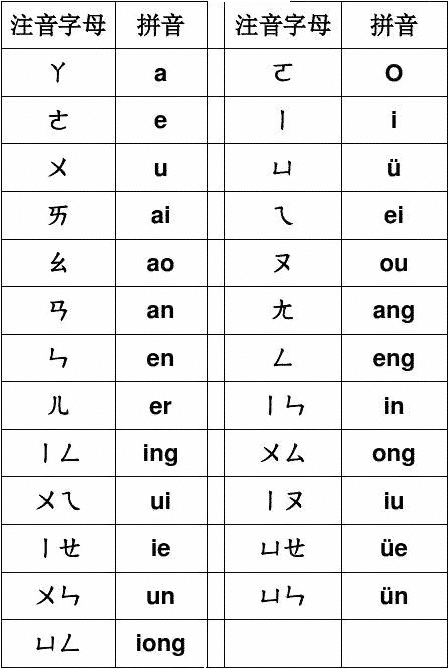Unlike English, French, or Spanish, Chinese is not a phonetic language. However, two popular phonological systems are often used to help beginners (and native children) learn the Mandarin sounds – Hanyu pinyin 拼音 and zhuyin 注音. In the early 20th century, literacy level was less than 45% for men and less than 10% for women. To improve literacy among the general population, there was a major push to write in a more vernacular style to reflect the expressions spoken by the common folks. The same movement prompted the simplification of the Chinese language, resulting in the existence of both the traditional Chinese (used in Taiwan) and the simplified Chinese (used in China).

Pinyin 拼音
With the founding of the People’s Republic of China in 1949, Hanyu Pinyin 拼音 became the new standard for teaching Chinese in China. Using the 26 Latin alphabets and diacritics to mark the four tones in the Chinese language, pinyin is widely taught and used even today. The simple chart to the right shows the different pinyin combinations. For more information about pinyin, check out its wiki page.

Zhuyin 注音
Zhuyin 注音 (aka bopomofo) was introduced by the Republican Government (aka KMT or 國民黨, Guómíndǎng) in the 1910s and consist of 37 characters and four tone marks, transcribing all possible sounds in Mandarin. Today, it is used primarily in Taiwan where children are expected to learn the zhuyin system prior to learning Chinese characters. The chart on the left shows the zhuyin characters and how they correlate to pinyin. To learn more about the zhuyin system, check out its wiki page.
Which system is better?
Neither. Each has its own distinct advantages, some of which are listed below.
Pros of Pinyin

- Pinyin does not require learning “new” alphabets as they utilize the same Latin characters that speakers of English (and close cognate languages) already recognize. This is the the biggest pro AND the biggest con for non-native learners. Read about a learner’s reflections here.
- For English speakers, Pinyin is easier to learn as many of the sounds carry familiar pronunciations as the English phonics. The flip side of this coin is that not all sounds are the same in pinyin as they are in English, which may be rather confusing, especially for young learners exposed to both languages simultaneously.
- Pinyin is much more widely used than Zhuyin. For Chinese learners, this means access to more resources.
- Pinyin is easier to “type” as the Latin-based keyboard is familiar to English speakers.
Pros of Zhuyin
- Since zhuyin does not utilize the Latin alphabets, there is no confusion between zhuyin sounds with English phonics.
- Zhuyin reflects the Mandarin sounds (and structures) better than pinyin as the system was created uniquely for the Mandarin language. On the flip side, it does take a longer time to learn.
- Zhuyin is strategically placed “next” to the Chinese characters to help brains naturally associate the sound with the characters while reading. Pinyin, on the other hand, is placed on a different line altogether so that the brain can completely bypass the Chinese characters with pinyin.
- Many of the zhuyin symbols are derived from Mandarin radicals, helping children associate between the sounds and characters better.
- Zhuyin is more efficient as it utilizes the minimal number of symbols to represent a given syllable.

Which system should your child learn?
The two key factors are:
1. Is your child learning simplified Chinese or traditional Chinese? For simplified Chinese learners, pinyin is the better choice. For traditional Chinese learners, zhuyin is the preferred choice.
2. Where are you getting your learning resources? If you have family and friends from Taiwan, chances are you are getting books with zhuyin. If you are buying books from Taobao or Amazon, the resources are more likely to come with pinyin.
What system is used on Little Chinese Readers lessons and stories?
Both! Just as all of our lessons, stories, worksheets, and games are available in simplified and traditional Chinese, they also come with both pinyin/zhuyin to help children read. For learners who already knows one of these systems, they can toggle them on or off as they go through our guided courses. For children who have not yet learned zhuyin or pinyin, that’s fine too! In fact, there’s a growing trend (even in China) to skip pinyin altogether and go straight to learning the characters. Just tap the individual Chinese character in each of our books and lessons to learn its sound or turn on the audiobook mode to hear the book read aloud. Sign up for your free lifetime account and start your child on lesson 1 today.

